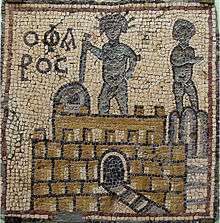Olbia, Libya
.jpg)
Olbia or Theodorias was a Roman / Byzantine town between Marj and Bayda in the Cyrenaica region of modern Libya.[1][2][3] Olbia is now mostly the archaeological site. The location's modern name is Qasr Libya, after the Islamic period castle (Qasr) on the site and Libya or Lebia as a corruption of the ancient name Olbia.
History
After destruction by the Vandals and incursions by Laguatan (Lwatae) nomads, it was refounded in 539 CE as Polis Nea Theodorias[4] by the Byzantine empress Theodora.[5]

All that remains of the town are two Byzantine churches. One is integrated into the Qasr, which now houses the Qasr Libya Museum. The other church was excavated by Richard Goodchild in the mid 1950s.[6][7] [8] Only the floor plan remains, but fifty beautiful mosaic panels depicting the known world and the refoundation and adornment of the city by Theodora are on display in the museum.[9] In one of these, two mosaics reveal the names of Macario and Teodoro bishops, the latter being qualified as a "new bishop," presumably Macario's successor.[10]
Bishopric
There are five known ancient bishops of this ancient diocese.[11][12] The first two are mentioned in the letter written by Sinesio di Cirene to Theophilus of Alexandria in 412, in which the author communicates to the Archbishop of Alexandria that after a long ministry and a long life died "the very best Father Athamas"; That the faithful of Olbia unanimously chose as his successor Antonio, an honest and just man.[13]
Bishop Publius took part in the Council of Ephesus 431.
Since 1933 Olbia has been included among the bishopric holders of the Catholic Church; The title is no longer assigned from May 26, 1978.[14][15] [16]
Known bishops
- Athamas (fl.412)
- Antonio (fl. after 412 )
- Publio (fl.431)
- Macario (fl.539/540)
- Theodoro (fl.539/540)
- Tihamér Tóth (1938–1939)
- James Colbert (1939–1955)
- Elie Vandewalle (1958–1960)
- Arcângelo Cerqua,(1961–1978)
Notes
- ↑ Denis Roques, Synésios de Cyrène et la Cyrénaïque du Bas-Empire, Paris 1987.
- ↑ G. Ambrosetti, Qasr el-Lebia, Enciclopedia dell'Arte Antica, 1965.
- ↑ Theodorias (Qasr Libya) sul sito Livius.Org.
- ↑ Beckwith, John (1993) Early Christian and Byzantine Art Yale University Press, New Haven, Connecticut, p. 74, ISBN 0-300-05296-0
- ↑ Roques è cauto nell'identificazione dell'antica Olbia con Polis Nea Theodorias e dunque con Qasr el-Lebia, dove si trovano le rovine della città bizantina costruita da Teodora. Synésios de Cyrène et la Cyrénaïque du Bas-Empire, pp. 106–107.
- ↑ Pliez, Olivier (ed.) (2009) "Qasr Libya (Olbia-Theodoria)" Le Petit Futé Libye Petit Futé, Paris, p. 241, ISBN 2-7469-2276-2; in French
- ↑ Richard Goodchild: The Great, newly discovered mosaic floor of Qasr el-Lebia. London Illustrated Evening News, 14. December 1957.
- ↑ Gwyn Williams: Green Mountain - an informal guide to Cyrenaica and its Jebel Akhdar. (Faber and Faber, 1963).
- ↑ Azema, James (2000) "East of Barce" Libya Handbook: The Travel Guide p. 163, Footprint Travel Guides, Bath, England, ISBN 1-900949-77-6
- ↑ Roques, Synésios de Cyrène et la Cyrénaïque du Bas-Empire, pp. 338 e 340.
- ↑ Pius Bonifacius Gams, Series episcoporum Ecclesiae Catholicae, (Leipzig, 1931), p. 462
- ↑ Michel Le Quien, Oriens christianus in quatuor Patriarchatus digestus, (Paris, 1740),volII, coll. 629-630.
- ↑ Roques, Synésios de Cyrène et la Cyrénaïque du Bas-Empire, pp. 106, 335, 340, 359, 362.
- ↑ Roques, Synésios de Cyrène et la Cyrénaïque du Bas-Empire, pp. 106, 335, 340, 359, 362.
- ↑ Entry at www.gcatholic.org.
- ↑ , at Catholic-Hierarchy.org.
References
- Goodchild, Richard. The Great, newly discovered mosaic floor of Qasr el-Lebia. London Illustrated Evening News , Dec. 14th 1957
- Williams, Gwyn. Green Mountain - an informal guide to Cyrenaica and its Jebel Akhdar. Faber and Faber 1963